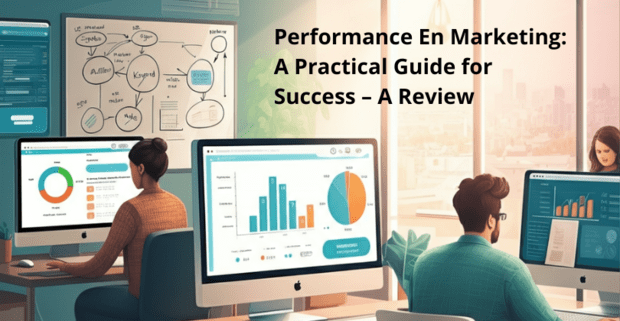What is Performance Marketing
The guide starts with a clear explanation of performance marketing focuses and tips, including search marketing, describing it as a strategy that’s about measurable actions not traditional ad placements and highlights the importance of choosing the right performance marketing channel. It talks about real-time tracking and search engine optimization as part of a broader marketing strategy where advertisers pay marketing companies for completed actions such as clicks, leads or sales. By adopting a performance based approach advertisers pay only for completed actions such as clicks, leads or sales, so it’s a cost effective way to target your audience and refine campaigns on the fly.
Benefits of Performance Marketing:
-
Efficiency: Advertisers only pay for tangible results.
-
Data driven: Campaigns can be adjusted quickly.
-
Control: Ads can be paused or optimised.
-
Flexibility: Suitable for businesses with small or big budgets.
What is Performance Marketing
Performance marketing is a dynamic and results driven approach to digital marketing and advertising, which includes various types of performance marketing that’s about measurable outcomes. Here are the key features that make performance marketing a powerful tool for businesses:
-
Measurable Results: At the heart of performance marketing is the ability to track and measure every aspect of a campaign. This includes clicks, conversions, leads and sales, so you can see how your marketing is working and make data driven decisions.
-
Cost Efficient: Advertisers pay marketing companies only for completed actions, such as clicks, leads or sales, so marketing budgets are spent efficiently. This pay for performance model reduces waste and maximises ROI.
-
Real Time Tracking: Performance marketing campaigns are tracked in real-time, so marketers can make adjustments and optimise their strategy for better results. This agility is key in a fast paced digital world.
-
Targeted Audience Engagement: Performance marketing is about reaching specific target audiences with tailored messaging. By understanding the demographics, interests and behaviours of your potential customers you can deliver highly relevant and personalised content.
-
Multiple Channels: Performance marketing encompasses multiple channels including search engine marketing, social media advertising, affiliate marketing and email marketing. Each channel has its own benefits so you can create a well rounded and effective marketing strategy.
-
Data Driven Insights: are at the heart of successful performance marketing campaigns. By using analytics and tracking tools you can adjust your marketing strategy in real-time based on performance data. This allows you to optimise campaigns, pause underperforming ads and allocate resources more efficiently. With data driven insights marketing companies can make informed decisions that improve campaign performance and ensure every marketing effort aligns with business goals and target audience preferences.
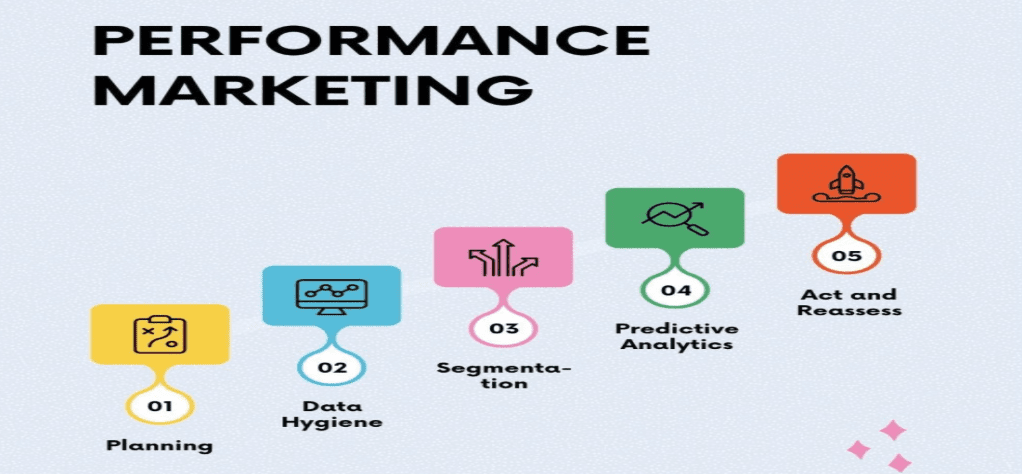
How Does Performance Marketing Work?
The guide explains how performance marketing tactics bridge the gap between advertisers, publishers and affiliate networks. Advertisers define their campaign goals, publishers promote products/services and marketing companies provide the tools for managing programs. This partnership is key to transparency and measurable outcomes aligned with business goals .
Getting Started with Performance Marketing
Starting a performance marketing journey requires a strategic approach to succeed. Here’s a step by step guide to get you started:
-
Define Your Goals and Objectives: The first step in any performance marketing strategy is to set clear, measurable goals. Whether you want to increase website traffic, generate leads or boost sales, having specific objectives will guide your efforts and provide a benchmark for success. Use the SMART criteria—Specific, Measurable, Achievable, Relevant and Time-bound—to set your goals.
-
Identify Your Target Audience: Understanding your target audience is key to crafting effective marketing strategies. Conduct thorough market research to identify the demographics, interests and behaviours of your potential customers. This insight will help you tailor your messaging and choose the right performance marketing channels to reach and engage your audience.
-
Choose the Right Performance Marketing Channels: Selecting the right channels is crucial for the success of your performance marketing campaigns. Evaluate multiple performance marketing channels such as search engine marketing, social media advertising, affiliate marketing and email marketing. Choose the ones that align with your goals and resonate with your target audience. Each channel has its own benefits so a mix of channels can often yield the best results.
-
Create a Performance Marketing Strategy: A performance marketing strategy should include multiple channels and tactics. Create a detailed plan that outlines your approach for each channel, including budget, ad creative and targeting criteria. Make sure your strategy is flexible enough to adapt to changing market conditions and performance data.
-
Set Up Tracking and Measurement Tools: Tracking and measurement tools are essential for monitoring your campaigns. Use analytics platforms like Google Analytics, Facebook Ads Manager and affiliate network software to track key metrics such as cost per click (CPC), cost per acquisition (CPA) and return on ad spend (ROAS). Review this data regularly to identify trends, optimise your campaigns and make data driven decisions.
By following these steps you can set up a solid foundation for your performance marketing efforts so your campaigns are targeted, efficient and results driven.
Performance Marketing Channels
The guide goes into the various types of performance marketing channels available including the top performance marketing channels and how each one contributes to campaign success:
1. Search Engine Marketing (SEM) & Paid Search:
Paid search ads allow brands to target specific keywords directly relevant to their audience. Search engine marketing involves paid ads, search engine optimisation (SEO) is about improving organic search rankings to drive traffic and enhance campaign performance over time. This channel which includes search engine marketing is good for driving traffic, generating leads and high intent conversions. Advertisers only pay for completed actions so budget is controlled. Marketers have transparency of paying per click so every dollar is tied to results.
2. Social Media Marketing & Advertising:
Social media platforms are critical, as social media platforms like Facebook, Instagram and LinkedIn are known for their advanced audience targeting capabilities so social media advertising is a highly effective marketing strategy. With options to tailor social media marketing campaigns based on user demographics, interests and online behaviour social media is a great platform for lead generation and brand awareness at the same time. Influencer marketing is now recognised as performance marketing when it focuses on measurable results such as clicks and sales.
3. Content Marketing & Native Advertising:
Performance marketing means creating valuable content including native ads . Native advertising is a form of native advertising that blends promotional content with informative content so marketers can integrate ads into content platforms. Native advertising blends sponsored content with the surrounding editorial so it’s less intrusive. These tactics include content marketing and the benefits of performance marketing to help brands connect with audiences and drive measurable conversions. Content marketing costs 62% less than outbound marketing and generates 3x more leads so it’s a very efficient strategy for performance marketers.
4. Affiliate & Email Marketing:
Affiliate programs are core to performance marketers and are a performance marketing channel. An affiliate marketer serves as brand ambassadors in affiliate marketing promoting products to niches or wider markets. Affiliate marketing is when an affiliate promotes a company’s products and earns a commission for each sale made. Affiliates earn commissions for driving clicks or sales to third-party advertisers through their marketing efforts. Email marketing is a trusted way to nurture leads, encourage loyalty and deliver laser focused messaging.
Types of Performance Marketing
To cater to different campaign goals the guide covers several performance based advertising models and payment systems including key performance indicators :
-
Cost Per Acquisition (CPA): Payment is made when a conversion occurs.
-
Cost Per Lead (CPL): Advertisers pay for each lead generated. Cost per lead (CPL) is the cost incurred when someone signs up or provides their contact details.
-
Cost Per Click (CPC): Payment is tied to ad clicks, driving traffic.
-
Cost Per Mille (CPM): Advertisers pay per 1,000 impressions.
Each one serves a business need and can be chosen based on campaign objectives.
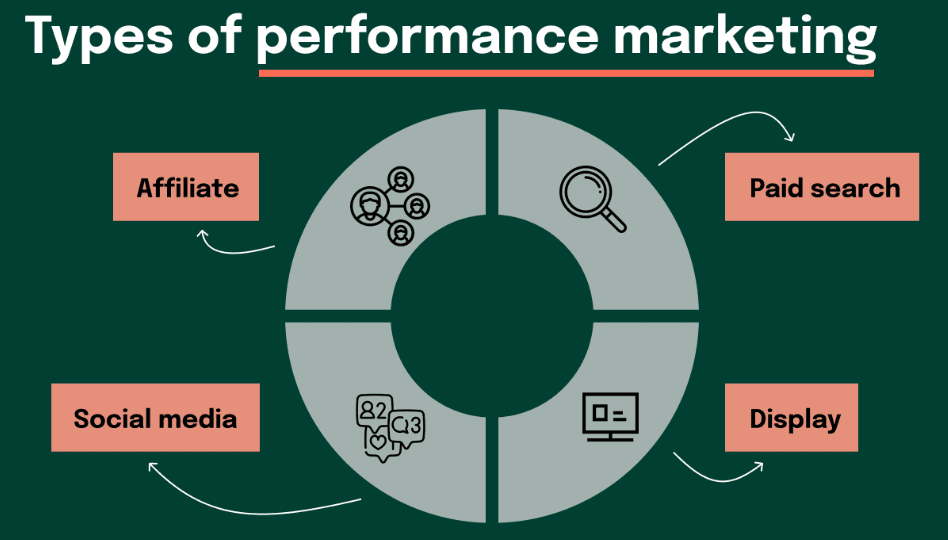
Performance Marketing Strategy
Excels in outlining the steps to create a digital marketing performance marketing strategy including banner ads :
-
Define Goals & KPIs: Identify the metrics that will measure success, CPA, CPL or ROI.
-
Choose Ideal Channels: Align channels with audience behaviour and campaign goals—be it search engines, social media or any other performance marketing channel like affiliate marketing or email marketing.
-
Launch & Track Campaigns: Use analytics tools to monitor campaign performance and optimise as needed, adjust ad copy, bids or creatives for better results.
Launching and Optimising Performance Marketing Campaigns
Launching and optimising performance marketing campaigns requires a strategic approach to get the desired results. Here are the key steps to consider:
-
Define Clear Goals: Set specific, measurable, achievable, relevant and time-bound (SMART) goals for your performance marketing campaign. This will help you focus on the desired outcomes and track progress.
-
Choose the Right Channels: Select the most effective performance marketing channels for your campaign, social media, search engine marketing or affiliate marketing. Consider your target audience, budget and desired outcomes when making your choice. Each channel has its unique benefits so aligning them with your campaign goals is crucial.
-
Create Engaging Ad Creative: Develop high quality ad creative that resonates with your target audience and drives conversions. Use attention grabbing headlines, compelling copy and eye-catching visuals to make your ads stand out. Tailor your message to the platform and audience can make a big difference in engagement.
-
Set Up Tracking and Analytics: Implement tracking and analytics tools to measure the performance of your campaign. This will help you monitor key metrics, cost per click (CPC), cost per acquisition (CPA) and return on ad spend (ROAS). Accurate tracking is essential to know what works and what needs to be adjusted.
-
Optimise and Refine: Continuously optimise and refine your campaign based on performance data. Adjust targeting, ad creative and bidding strategies to improve results and achieve your goals. Regularly review and tweak your approach to ensure your campaign remains effective and efficient.
By following these steps you can launch and optimise performance marketing campaigns that deliver measurable results and maximum ROI.
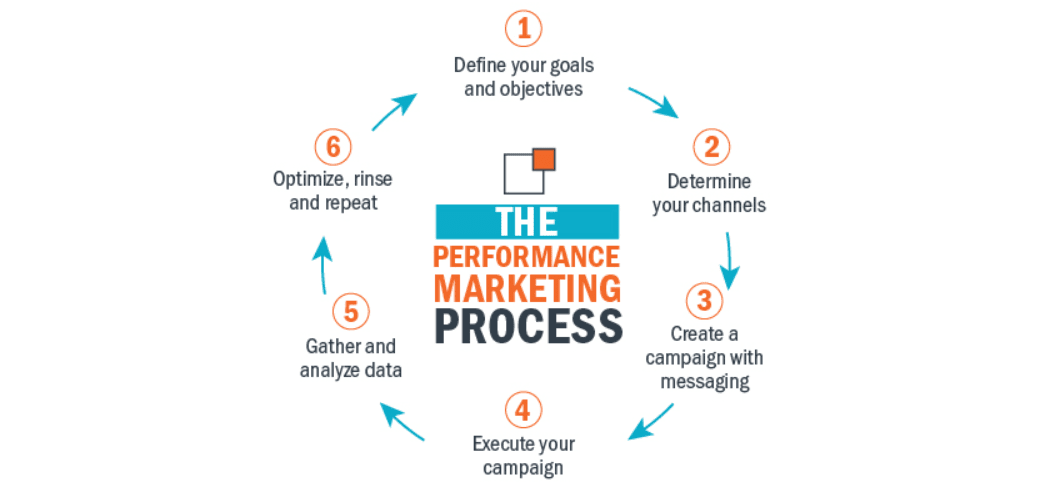
Measuring Success with Performance Marketing
Understanding metrics is key to improving campaigns. Metrics like Lifetime Value (LTV) and Return on Ad Spend (ROAS) help marketers evaluate long term customer value and determine overall campaign effectiveness. By recognising patterns in these numbers businesses can refine their strategy to amplify their impact over time.
Case Studies
The guide includes real-world examples and performance marketing examples , looking at both success stories and failures in performance marketing. These case studies provide valuable insights to boost brand awareness into setting realistic expectations with marketing partners, avoiding program pitfalls and taking calculated risks. For example what might seem like a well targeted campaign could fail due to a mismatched payment model or poor audience segmentation—issues the performance marketing program guide breaks down. Tools make all the difference. The guide shows how advertising platforms like Google Ads, Facebook Ads Manager or even advanced affiliate network software can simplify campaign management and data collection. Technology ensures precision and streamlines performance tracking to avoid waste.
Common Mistakes and How to Avoid Them
No performance marketing guide would be complete without tips on how to avoid costly errors and the benefits of performance marketing . Key mistakes highlighted include poor audience targeting, bad marketing messages, relying on performance based advertising and not targeting specific audiences and not analysing real-time data quickly. By learning to spot these mistakes early on marketers can save time and budget.
Future of Performance Marketing
The future of performance marketing is exciting and fast paced. Here are the key trends and predictions:
-
More Artificial Intelligence (AI): AI will play a bigger role in performance marketing, enabling more efficient and effective campaign optimisation, targeting and ad creative development. AI driven tools can analyse huge amounts of data to find patterns and predict outcomes, allowing for more precise and personal marketing.
-
Voice Search: Voice search will become more important and performance marketers will need to adapt their strategies to accommodate this. Optimising for voice search means focusing on natural language queries and making sure content is accessible through voice activated devices.
-
Growing Video Content: Video content will continue to grow and performance marketers will need to develop video ad strategies to engage their target audience. Video ads can grab attention quickly and convey messages more dynamically, making them a powerful tool for conversions.
-
More Transparency and Accountability: There will be more emphasis on transparency and accountability in performance marketing, with a focus on measurable, trackable and ROI driven campaigns. Marketers will need to provide clear reporting and prove the value of their work to stakeholders.
-
Customer Experience: Performance marketers will need to prioritise customer experience, developing campaigns that are personal, relevant and engaging. Understanding customer journeys and creating seamless, enjoyable interactions will be key to building long term relationships and repeat business.
By staying ahead of these trends performance marketers can continue to innovate and succeed in a fast changing digital landscape.
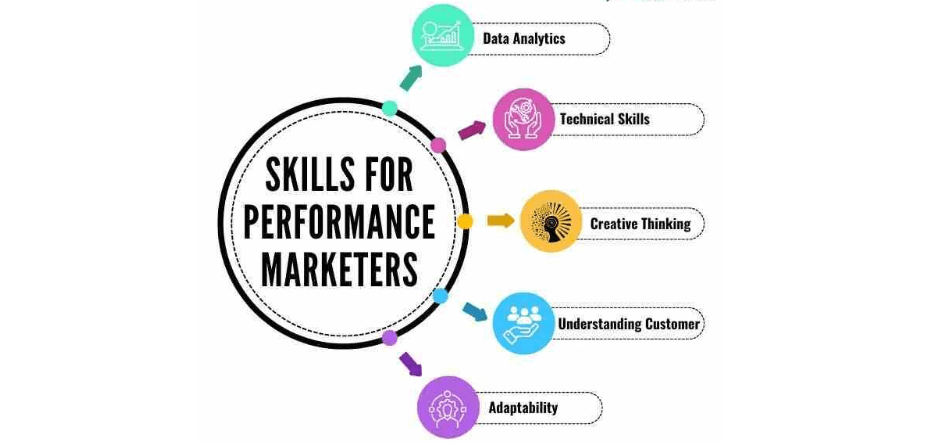
Why You Need to Read This
For affiliates, webmasters and marketing professionals, Understanding Performance in Marketing covers both the basics and advanced strategies of performance marketing and digital marketing. It explains complex terms but doesn’t shy away from advanced insights.
Who Will Benefit?
- Affiliates: Learn to maximise earnings and build successful partnerships.
- Webmasters: Get actionable SEO and traffic optimisation tips.
- Marketing Managers: Deploy and manage large scale campaigns efficiently.
- Business Students: Perfect introduction to the professional applications of marketing strategy.
FAQ
What is a digital marketing strategy in performance in marketing?
Performance in marketing means being able to measure, analyse and optimise marketing campaigns based on specific results such as leads, conversions or sales. It’s about accountability and measurable outcomes.
What is performance marketing?
Performance marketing is a results driven digital marketing strategy where advertisers pay to measure performance marketing only when a specific action, such as a click, lead or sale or search engine optimisation is completed. It’s all about ROI and measurable success metrics.
What is performance based marketing?
Performance based marketing is another term for performance marketing, where payment to advertisers or publishers is directly tied to achieving predefined goals, performance marketing is about ensuring accountability and efficiency.
Is performance marketing the same as SEO?
No, performance marketing and SEO are different. Performance marketing involves paid advertising to achieve immediate and measurable results, while SEO is an organic strategy to improve search engine rankings over time.
What does a performance marketing specialist do?
A performance marketing specialist marketing agencies manages and optimises paid advertising campaigns across platforms, tracks key performance metrics and implements data driven strategies to maximise ROI.
What does a performance marketer do?
A performance marketer creates, executes and refines campaigns to achieve measurable results like clicks, leads or sales. They work closely with analytics to optimise performance and enhance efficiency.
What is an example of performance marketing?
An example of performance marketing is a pay per click (PPC) ad campaign where advertisers pay each time a user clicks their ad, driving traffic to their website with trackable results.
Is performance marketing a good job?
Yes, performance marketing is a great career for individuals interested in data driven strategies, campaign management and digital marketing. It offers growth opportunities and is a key part of modern business strategies.
What is performance marketing?Performance marketing is defined by its focus on content marketing outcomes, accountability and ROI driven advertising strategies, using platforms like social media, search engines and affiliate networks.
What is the performance marketing role?
The role of performance marketing is to develop and manage campaigns to achieve specific business objectives such as generating leads, increasing sales or enhancing brand visibility.
What is performance marketing with an example?
Performance marketing involves campaigns like search marketing and affiliate marketing where publishers are paid for driving a sale or lead, ensuring measurable and cost effective outcomes.
What is the goal of performance marketing?
The primary goal is to achieve key metrics that represent measurable results aligned to business objectives such as increasing revenue, generating leads or driving conversions while maximising ROI.
What is the difference between paid marketing and performance marketing?
Paid marketing includes any digital advertising where businesses pay for exposure, while performance marketing is specifically results driven, with payment tied to completed actions like clicks or sales.
What is a performance marketing strategy?
A performance marketing strategy involves creating a performance marketing plan, planning, executing and optimising campaigns using outsourced program management services and platforms like Google Ads, social media or affiliate networks to achieve specific, measurable goals.
What are the 4 marketing strategies?
The 4 marketing strategies, often referred to as the 4 P’s are Product, Price, Place and Promotion, which form the foundation of any marketing plan.
What is performance marketing in digital?
Digital performance marketing performance en marketing refers to online advertising campaigns designed around measurable actions, including native advertising using platforms such as Google Ads, social media or influencer marketing to drive outcomes.
Is performance marketing worth it?
Yes, when executed well performance marketing is highly worth it as it pay marketing service providers ensures advertisers invest only in campaigns that deliver desired actions, maximising ROI.
What is the meaning of marketing performance?
Marketing performance refers to the evaluation and measurement of how marketing strategies achieve business objectives, using data and analytics to assess and improve outcomes.
What do you mean by market performance?
Market performance involves analysing how products or services perform in the market, focusing on sales, customer engagement and competitive positioning.
What is the 3-3-3 rule in marketing?
Although not universally defined, the 3-3-3 rule in marketing typically means aligning three key objectives, three marketing strategies and three measurement criteria to streamline and focus campaigns efficiently.
What are the 4 P’s of marketing?
The 4 P’s of marketing—Product, Price, Place, and Promotion—apply traditional marketing principles to digital, focusing on targeted and personalisation.
Conclusion
Performance marketing is changing the way businesses advertise and every dollar counts. This article has explained the basics and given you practical steps to create strategies that deliver results through performance marketing .
Ready to get started with performance marketing or refine your existing campaigns? Read Performance in Marketing today and get precision marketing for your audience.
For more information, talk to industry experts or use tools and analytics platforms to power your campaign.


